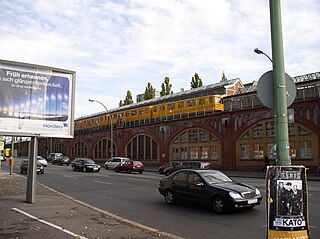
U1 is a line on the Berlin U-Bahn, which is 8.8 kilometres (5.5 mi) long and has 13 stations. Its traditional line designation was BII. It runs east–west and its eastern terminus is Warschauer Straße S-Bahn station where it connects to the Schlesische Bahn. From there it runs through Kreuzberg via Gleisdreieck and Wittenbergplatz on to the Kurfürstendamm.

U2 is a line of the Berlin U-Bahn. The U2 line starts at Pankow S-Bahn station, runs through the eastern city centre (Alexanderplatz) to Potsdamer Platz, the western city centre and finally to the Ruhleben terminal station.

Jakob-Kaiser-Platz is a metro station on the Berlin U-Bahn line U7, located in the Charlottenburg-Nord district. It was opened on 1 October 1980 with the line's extension from Richard-Wagner-Platz to Rohrdamm. The eponymous traffic circle located above the station is named after politician and Resistance fighter Jakob Kaiser (1888–1961). The next station going eastbound is Jungfernheide
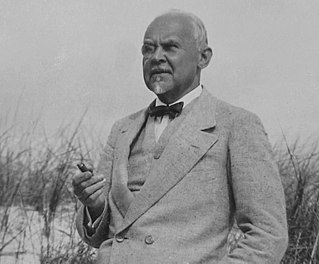
Alfred Frederik Elias Grenander was a Swedish architect, who became one of the most prominent engineers during the first building period of the Berlin U-Bahn network in the early twentieth century.
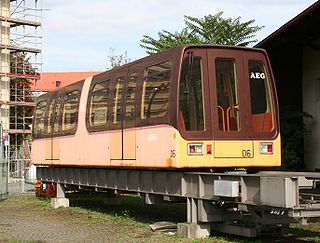
The M-Bahn or Magnetbahn was an elevated Maglev train line operating in Berlin, Germany, experimentally from 1984 and in passenger operation from 1989 to 1991. The line was 1.6 kilometres (0.99 mi) in length, and featured three stations, two of which were newly constructed. Presumed to be the future of rail transit in Berlin, the line was built to fill a gap in the West Berlin public transport network created by the construction of the Berlin Wall. It was rendered redundant by the reunification of Berlin and was closed to enable reconstruction of the U2 line.

Berlin Schönhauser Allee is a railway station in the Prenzlauer Berg district of Berlin. It is located on the Berlin U-Bahn line and also on the Ringbahn . Built in 1913 by A.Grenander opened as "Bahnhof Nordring". As the station was well accepted the roof was elongated in 1925 and a new entrance build. In 1936 the station was named "Schönhauser Allee". On an average day approximately 500 trains and more than 26000 people cross this station.

Deutsche Oper is a station of the Berlin U-Bahn on line U2, located in the Charlottenburg district. It is named after the Deutsche Oper Berlin.
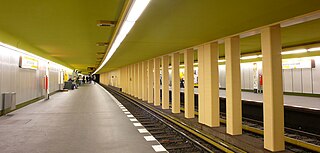
Bismarckstraße is a Berlin U-Bahn station on lines U2 and U7, located in the Charlottenburg district. It was opened in 1978 on the eponymous street, a major arterial road named after Otto von Bismarck.

Theodor-Heuss-Platz is a station on line U2 of the Berlin U-Bahn, located in the Westend district.

The Bundesstraße 5 is a German federal highway running in a northwesterly to southeasterly direction from the Danish border near Niebüll to Frankfurt (Oder). It provides a direct route for motorists traveling between Berlin and Hamburg. In Berlin B5 forms among others the following squares and streets Heerstraße, Theodor-Heuss-Platz, Kaiserdamm, Straße des 17. Juni, Großer Stern, Unter den Linden, Karl-Liebknecht-Straße, Alexanderplatz, Karl-Marx-Allee, Frankfurter Tor, and Frankfurter Allee. The section north of Hamburg is partially paralleled by Bundesautobahn 23.
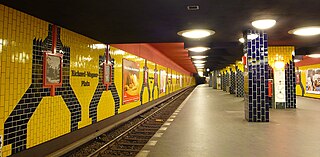
Richard-Wagner-Platz is a Berlin U-Bahn station located on the in the Charlottenburg district.

Adenauerplatz is a Berlin U-Bahn Station on the U7 line in the district of Charlottenburg, borough of Charlottenburg-Wilmersdorf. It was opened on 28 April 1978 after the north-west extension to Spandau, and is located on the Kurfürstendamm/Lewishamstrasse intersection.

Stralauer Tor was a Berlin U-Bahn station in Berlin-Friedrichshain. It operated between Warschauer Straße and Schlesisches Tor stations on today's U1. Following its destruction in World War II it was never rebuilt and remains to this day one of Berlin's two U-Bahn stations to have been abandoned after having previously been in service.

Westend is a locality of the Berlin borough Charlottenburg-Wilmersdorf in Germany. It emerged in the course of Berlin's 2001 administrative reform on the grounds of the former Charlottenburg borough. Originally a mansion colony, it is today a quite densely settled, still affluent territory adjacent to Berlin's inner city in the east.

Berlin-Wannsee station is a railway station opened in 1874 which lies in the Wannsee district of Berlin, the capital city of Germany. It is an important traffic junction in south-west Berlin that is served by the RegionalExpress and RegionalBahn trains of the Deutsche Bahn, the Harz-Berlin-Express of Veolia Verkehr and by the Berlin S-Bahn. In summer, Wannsee serves as the Berlin terminal for DB AutoZug car carrying trains to and from southern Europe.

Berlin Brandenburger Tor – formerly Berlin Unter den Linden (1936-2009) – is an underground railway station in the central Mitte district of Berlin, Germany, located on the Unter den Linden boulevard near Hotel Adlon, Pariser Platz and Brandenburg Gate. It is served by the Berlin S-Bahn and U-Bahn, as well as local bus lines.

The Cologne Ring is a semi-circular, some 6 km long urban boulevard in Innenstadt, Cologne and the city's busiest and most prominent street system. The Cologne Ring is a four lane street and part of Bundesstraße 9.

Heerstraße runs from Theodor-Heuss-Platz in Berlin-Charlottenburg to the western city border of Berlin in the locality of Staaken in the borough of Spandau. It is part of Bundesstraße 5; from Theodor-Heuss-Platz to Wilhelmstraße it is forms part of Bundesstraße 2. With a length of around 10 kilometres, it is one of the longest streets in Berlin and an important commuter route. The street is a five-lane expressway (Kraftfahrstraße), depending on traffic flow the middle lane is available during rush hours in the morning (eastbound) and in the evening (westbound).

Theodor-Heuss-Platz is a large city square in the Westend district of Berlin, Germany. It is named after Theodor Heuss (1884–1963), the first President of Germany after World War II.

The history of the Berlin U-Bahn took its origins in 1880 with an excitation of the entrepreneur Werner Siemens in Berlin to build a high end subway. In the nine years after the founding of the German Empire, the inhabitants of Berlin had risen by over a third, causing increasing traffic problems. Beginning in 1896 then began Siemens & Halske with the construction of the first stretch as overhead railway. On 1 April 1897, the company has been established for electric elevated and underground railways in Berlin, which took over the further construction and operation and 1929 went up in the Berlin transport company. The 1938 in BVG renamed company was operating the city of Berlin. The BVG is since 1994 a public institution.





















